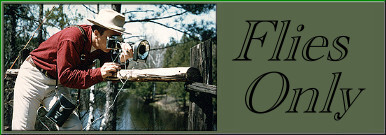|
Below is a picture of the fly Vince gave me. Study
it most carefully. Several important features are
evident. Notice the 'outrigger' tails. For the sub-imago
(dun) the split tails keep the fly from rolling or
falling over. These are a very necessary part of the
whole.

Other items of note are: the height, location, and tilt
of the two wings, the lack of any abdomen, the placement
of the thorax central on the hook shank, and the X winding
of the hackle. The hackle wound this way does not penetrate
the water as conventional hackle does, but allows the fly
to ride on the tips of the hackle barbles.
In the second picture the fly is seen from above. Notice
how the split tails keep the fly upright. Although the fly
was at rest on the surface for several minutes (about 30)
it maintains it's posture and the hackle tips remain
spread out on the surface.

The picture below is a fly I tied as I attempted to
follow the directions on his book, A Modern Dry Fly Code.
I believe I made a horrid thing of it. I used what I
had on hand and it shows. I really messed up the body
by making it too long and not getting it in a ball central to the hook shank for the thorax. Nevertheless, it floated.

I will say I did not find the instructions crystal clear
as to how to tie the fly. Forgive me, it was my first
attempt. No excuse, I had his to look at and still
botched the job. Old habits are hard to break. This
is not an easy fly to learn. Once learned, however,
it is very simple.
Next time, we go underwater and take a look.
J. Castwell
Back to Index
If you would like to comment on this or any other article please feel free to
post your views on the FAOL Bulletin Board!
|







